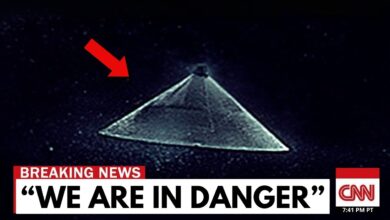There Could Be LIFE on Titan and It’s Even Weirder Than You Think!

Titan, Saturn’s largest moon and the second largest in the solar system, has a unique atmosphere with clouds and a dense, planet-like composition. This moon’s conditions could offer insights into the early Earth and the origins of life. Unlike Earth, Titan is colder due to its distance from the Sun, with its surface shrouded in an orange haze that hid it from scientists until the Cassini mission in 2004.
Titan’s atmosphere extends about 370 miles high and is rich in organic compounds, which on Earth are linked to life. Despite its frigid surface, Titan has rivers, seas, and lakes of liquid hydrocarbons, and beneath its icy crust, a subsurface ocean of water might exist. This could potentially support chemical evolution similar to early Earth, but current conditions are too cold for life as we know it.
In the future, as the Sun becomes a red giant, Titan might warm up enough to support stable oceans of water-ammonia mixtures, creating an environment where life could potentially emerge. However, the presence of ammonia might slow down chemical reactions necessary for life.
Enceladus, another moon of Saturn, has been identified as a top candidate for finding life due to its water-ice plumes containing life-essential molecules like ammonia and carbon dioxide. The Cassini spacecraft’s detailed analysis revealed a rich chemical diversity in Enceladus’ plumes, suggesting that it could support life. Future missions, such as NASA’s Dragonfly, aim to explore Titan further, investigating its potential for habitability and the presence of organic compounds necessary for life.
The search for extraterrestrial life continues to explore various moons and planets, with missions targeting places like Titan and Europa. While we haven’t yet found definitive proof of alien life, these investigations help us understand the potential for life elsewhere in the universe.
Scientists are still unsure if the planet Proxima Centauri b has an atmosphere. It orbits its star in just 11 Earth days and may have lost its atmosphere due to intense radiation, making liquid water unlikely. Gliese 832c, 16 light years away, is five times more massive than Earth and orbits a cooler red dwarf star. It may have a thick atmosphere causing a runaway greenhouse effect, making it more like Venus than Earth.
TOI 700 d, 100 light years away, orbits a cool dwarf star and may be in the habitable zone. It could potentially support life, though its surface conditions are still unclear. One model suggests it has a dense, carbon dioxide-rich atmosphere, while another depicts it as a land-dominated world.
GJ 504 b, in the Virgo constellation, is a pinkish exoplanet due to its residual heat. It’s 20 light years away and still glowing from its formation. There’s also a rogue planet with a powerful magnetic field, producing strong auroras. It’s larger than Jupiter and has an unusual way of creating these light shows.
A cold planet in the Sagittarius constellation is covered in ice with a surface temperature below 360°F. Despite the cold, scientists think there might be life beneath the ice due to internal heat.
One of the oldest known exoplanets, PSR B1620-26 b, is about 12.7 billion years old. It orbits a white dwarf and a pulsar.
J1407b, nicknamed “Super Saturn,” has rings 640 times larger than Saturn’s. It’s 434 light years away, and its rings have a gap where a Mars-sized moon might orbit.
WASP-12b is known for its extreme darkness, absorbing almost all light from its star, leading to surface temperatures up to 4,600°F. Its atmosphere occasionally spills material onto its star.
Another exoplanet, 55 Cancri e, may be mostly carbon and could be crystalline, possibly diamond-like.
WASP-76b has iron rain on its night side and extreme temperatures up to 4,300°F on the day side. Its orbit is very close to its star, causing tidal locking.
HD 189733b is a blue planet with winds reaching 5,400 mph and rain made of glass.
Enceladus, Saturn’s moon, recently had phosphorus detected, a crucial element for life. This discovery, along with evidence of a subsurface ocean, boosts hopes for life on this moon.
Europa, a moon of Jupiter, has a subsurface ocean beneath a thick ice layer. There might be shallow pools of water closer to the surface that could be easier to explore.
Titan, another moon of Saturn, has lakes of hydrocarbons and a deep subsurface ocean, making it a fascinating world with potential for life.
Mars also holds potential for life, with methane found in its atmosphere and evidence suggesting that bacteria might survive underground. Research continues to explore these possibilities.
Exoplanets, such as Proxima Centauri b, are being studied for their potential to resemble Earth and support life. Despite challenges, ongoing research aims to uncover these distant worlds’ secrets.
Europa, one of Jupiter’s moons, is intriguing due to its potential to host life. It’s slightly larger than Pluto and features a massive saltwater ocean beneath a 10-20 mile thick ice crust. This ocean is estimated to be 40-100 miles deep. Scientists believe that water plumes might erupt from the ice, possibly hinting at life. Recent discoveries suggest that there may be shallower pools of water closer to the surface, which could make future missions to explore life easier.
The idea that these shallow pools exist came from an accidental observation by scientist Riley Colberg, who noticed similarities between surface ridges on Europa and those on Earth. These ridges might result from a cyclical freezing and thawing process, indicating the presence of shallow water.
Phosphine, a gas that may indicate life, was once detected in Venus’s atmosphere, but later findings cast doubt on its presence. Venus’s harsh conditions, with its acidic clouds and extreme dryness, make the survival of life challenging.
Mars, another potential site for life, had methane detected in its atmosphere, suggesting possible microbial life. However, methane levels dropped rapidly, and conditions on the Martian surface are extremely harsh, with the possibility of life existing only in protected subsurface environments.
Io, one of Jupiter’s moons, is the most geologically active body in the solar system, with over 400 volcanoes. The intense volcanic activity is due to tidal forces from Jupiter and its other moons, which cause significant ground movement.
Ganymede, the largest moon in the solar system, has a thick ice crust and a potentially large ocean beneath it. This ocean may be salty and divided by icy sheets, with possible life existing near the rocky core.
Callisto, another of Jupiter’s moons, has a very ancient and stable surface, marked by numerous impact craters. It might have an ocean beneath its crust, but exploring it would be challenging due to its thick outer layer.
Mercury, the closest planet to the Sun, has a unique crater shaped like a spider, the origin of which is still debated. The planet’s formation remains a mystery, with theories suggesting it might have once been a moon of Venus or experienced significant collisions.
Uranus, a gas giant, rotates on its side, and has unusual dark spots and methane clouds that create intense storms. The reasons behind these phenomena are still under study.
This passage explores several intriguing mysteries of our solar system and beyond. Here’s a summary of the key points:
1. **Uranus’s Tilt**:
– Uranus is unique because its axis is almost horizontal, causing one pole to experience continuous daylight for 42 Earth years while the other remains in darkness. The cause of this extreme tilt is believed to be a massive collision with a protoplanet billions of years ago.
2. **Europa’s Potential for Life**:
– Europa, a moon of Jupiter, has an icy surface with potential liquid water beneath it. This ocean, warmed by tidal forces from Jupiter, might harbor microorganisms, but reaching it would require drilling through miles of ice.
3. **Titan’s Atmosphere**:
– Saturn’s moon Titan has a thick, nitrogen-rich atmosphere, similar to Earth’s. Its formation might be linked to past meteorite impacts that decomposed ammonia into nitrogen and hydrogen.
4. **Nemesis Hypothesis**:
– The hypothetical star Nemesis is theorized to be a companion to our Sun, potentially causing mass extinctions on Earth by disturbing asteroids. However, this star has not been discovered, and many scientists question the hypothesis.
5. **Oort Cloud**:
– The Oort Cloud is a hypothesized spherical shell of icy bodies surrounding our solar system, believed to be the origin of long-period comets. Some scientists suggest there might be a large, undiscovered gas giant in this region.
6. **Black Holes**:
– Black holes are regions in space where gravity is so strong that not even light can escape. They might contain extreme pressure or could be portals to other dimensions. The concept of white holes as exits from black holes remains theoretical.
7. **AER Odannis Supervoid**:
– The AER Odannis Supervoid is a vast, cold region in the universe, possibly caused by a collision between parallel universes. This explanation, while intriguing, is speculative.
8. **Phobos’s Grooves**:
– Mars’s moon Phobos has unusual grooves on its surface, potentially caused by a large impact, space debris, or tidal forces from Mars. The moon’s future is predicted to involve either a collision with Mars or disintegration.
9. **Mars Meteorite ALH 84001**:
– A Martian meteorite found in Antarctica contained structures resembling potential fossils. While initially exciting, further studies have cast doubt on whether these structures indicate life.
10. **Search for Extraterrestrial Life**:
– The concept of panspermia suggests that life could spread through space via meteoroids or comets. Though theoretical, this idea explores the possibility of life surviving harsh space conditions and traveling between planets.
These topics highlight ongoing efforts to understand the cosmos, from planetary phenomena and potential life beyond Earth to the nature of our universe.
This passage delves into various theories and experiments related to the origins and potential existence of life in space. Here’s a summary of the key points:
1. **Survival in Space**: Experiments have shown that certain microorganisms, such as bacterial spores and tardigrades, can survive in space conditions for extended periods. For example, bacterial spores exposed to Mars-like conditions remained viable, and seeds from such experiments have successfully grown into plants on Earth.
2. **Past Experiments**: Space missions, such as those involving the US Long Duration Exposure Facility and Russian Photon capsules, demonstrated that minimal protection could allow spores and tiny organisms to endure space for years. The Apollo 12 mission also found an Earth bacterium on the Moon’s surface that had survived unprotected for over two years, although it might have been contaminated in the lab.
3. **Panspermia Theory**: Panspermia suggests that life could spread across the cosmos via space dust, meteoroids, or comets. This theory gained some support from observations of microorganisms in the upper atmosphere and the transport of Earth bacteria by hurricanes. However, many scientists argue that if panspermia were true, life forms throughout the solar system would share biochemical characteristics, which is not observed.
4. **Astrobiology**: NASA’s astrobiology field aims to understand how life originated on Earth and how it might form on other planets. Initial missions like Viking to Mars failed to find evidence of extraterrestrial life, leading to debates on defining life and the risk of contaminating samples with Earth bacteria.
5. **Evolution of Life**: The development of life on Earth can be visualized as a progression through stages: from simple chemistry to complex multicellular organisms and eventually to advanced beings like humans. The “Great Filter” concept suggests that the jump from simple to complex life is rare and challenging, possibly explaining the lack of detected extraterrestrial civilizations.
6. **Search for Extraterrestrial Life**: NASA is focusing on detecting signs of life by studying exoplanets and extreme environments. Instruments like the James Webb Telescope are designed to look for signs such as liquid water, methane, and oxygen, which could indicate the presence of life.
7. **Extremophiles**: Extremophiles, organisms that thrive in extreme conditions, were discovered in deep-sea hydrothermal vents. This discovery suggests that life could survive in harsh environments similar to those found on other planets.
8. **Future Missions**: NASA’s upcoming missions, like the Europa Clipper and Dragonfly, aim to explore Jupiter’s moon Europa and Saturn’s moon Titan. These missions will gather data to assess the potential for life in these icy environments.
9. **Life’s Origins**: Theories about life’s origins include:
– **Cold Origins**: Life could have begun in icy conditions where important chemicals like amino acids are more stable.
– **Hydrothermal Vents**: Life might have started in the deep ocean’s vents, rich in essential elements and minerals.
– **Clay Hypothesis**: Clay particles could have played a role in organizing molecules and fostering early life.
– **Lightning and Phosphorus**: Lightning strikes may have contributed to the formation of phosphorus, an essential component of life, which could have sparked the development of living organisms.
These diverse theories and findings highlight the complexity of life’s origins and the ongoing quest to understand whether life exists beyond Earth.
**Summary:**
The text explores the origins of life on Earth and the potential for life on other celestial bodies. It begins with a discussion on how life on Earth might have begun with essential chemicals and minerals carried by meteorites. These meteorites, which collided with Earth about 4 billion years ago, brought carbon-based compounds crucial for life. Early life forms were simple microbes that evolved over billions of years. Around 2.4 billion years ago, photosynthesizing microbes began producing oxygen, which drastically changed the environment and led to the development of multi-celled organisms. This eventually gave rise to the first animals, such as sponges and jellyfish, about 800 million years ago. Evolution continued, leading to the appearance of vertebrates and, eventually, humans.
The text then shifts to discussing Uranus and its moons, focusing on their unique features and the potential for oceans beneath their icy surfaces. It describes the moons’ composition and the possibility that some may have salty oceans deep enough to support life. NASA is considering a mission to further explore these moons.
Finally, the text mentions Mars and the recent discoveries by NASA’s Perseverance Rover, which landed in the Jezero Crater—a dried-up river delta that might contain evidence of past life. Scientists hope to find traces of ancient microbes in this area, which could provide insights into whether Mars ever supported life.
**Exploring Mars with Sherlock**
NASA’s Rover uses a tool called Sherlock (Scanning Habitable Environments with Raman and Luminescence for Organics and Chemicals) to explore Mars. It detected strong signals of organic molecules at the Delta region, which were the brightest ever seen. This discovery led to the collection of 12 rock cores, including four from Skinner Ridge and Wildcat Ridge.
The Skinner Ridge cores, while similar to common Earth rocks, contain dark grains that might have come from a river that once flowed into Jezero Crater. These grains could help us learn more about Mars’ past. The cores from Wildcat Ridge are lighter and more uniform, possibly mudstone, and contain more organic matter than previous samples, hinting at possible ancient life.
However, organic molecules don’t always indicate life; they can form through other processes. More samples are needed to understand their significance. Perseverance is now exploring a new area called Enchanted Lake and will continue to study Jezero. NASA plans to send another mission to return these samples to Earth by 2027-2028 for detailed analysis.
**Searching for Life Beyond Earth**
Despite extensive searches, no extraterrestrial life has been found yet. While our galaxy has billions of stars and potentially habitable planets, no signs of life have been detected. Some moons, like Europa, might have subsurface oceans where life could exist.
Scientists have found some planets with conditions potentially better for life than Earth, but their exact nature remains uncertain. Advanced civilizations might use radio waves for communication, but we haven’t received any signals yet. Radio waves from Earth have only been detectable since 1895 and are now diminishing due to new technologies. This makes it difficult to detect extraterrestrial civilizations, but giant telescopes might someday help us find direct evidence of life on other planets.
### Mars Exploration
– **Sherlock Tool**: The Perseverance rover uses a sophisticated tool named “Scanning Habitable Environments with Ramen and Luminescence for Organics and Chemicals” (Sherlock) to detect organic molecules on Mars.
– **Delta Discovery**: The rover found strong signals of organic molecules in the Delta region of Jezero Crater, suggesting possible ancient life. These signals were among the brightest ever detected.
– **Rock Samples**: Since July 2021, Perseverance has collected 12 rock cores, including four from Skinner Ridge and Wildcat Ridge. The rocks from Skinner Ridge were less interesting, while those from Wildcat Ridge, containing mudstone and finer grains, held more organic matter.
– **Significance of Findings**: The finer-grain rocks might preserve ancient life forms, if any existed. While the discovery is significant, it’s not conclusive proof of life. Further analysis and additional samples are needed.
– **Future Missions**: NASA plans to send a Mars Sample Return mission with the European Space Agency to bring the Martian samples back to Earth for advanced analysis, with a launch planned for 2027-2028 and return expected by 2033.
### Search for Extraterrestrial Life
– **Habitable Zones**: Scientists look for planets in habitable zones where liquid water can exist—neither too hot nor too cold.
– **Computational Zones**: Researchers propose exploring “computational zones” which might support life using different chemicals, energy sources, and conditions. This includes looking for life in extreme environments, like icy moons.
– **Icy Moons**: Moons like Europa and Enceladus in our solar system are considered promising for life. Europa has a subsurface ocean and energy from Jupiter’s gravity, while Enceladus has water jets containing key life-supporting chemicals.
– **Chemical Diversity**: Enceladus’s water plumes have shown chemical diversity, making it a top candidate for potential life. The Cassini spacecraft collected data, revealing ammonia and carbon dioxide, crucial for life on Earth.
### Broader Implications
– **Advanced Civilizations**: The possibility of advanced civilizations in the universe might be limited by cataclysms or self-destruction. Advanced civilizations might use technologies we haven’t imagined or could have vanished before we could detect them.
– **Unique Earth**: Earth’s position in the galaxy, the formation of the Moon, and specific life-supporting conditions make our planet potentially unique. Alternative forms of life might exist based on different biochemical systems.
Cassini’s mass spectrometer initially detected five molecules in Saturn’s jets: water, carbon dioxide, ammonia, methane, and molecular hydrogen. Later, it was found that ethane, hydrogen cyanide, and methanol were also present. These heavier molecules suggest Saturn’s moons, like Enceladus, might have chemically active environments that could support life, similar to Earth’s hydrothermal vents.
Enceladus’s potential for life makes it a key target in the search for extraterrestrial life. The moon’s hydrothermal activity could create habitable conditions, although scientists haven’t yet confirmed this. Future missions, such as the European Space Agency’s Jupiter Icy Moons Explorer, will explore similar environments on Jupiter’s moon Europa, which may have properties akin to Enceladus.
Despite the potential for life, the Fermi Paradox raises questions: if conditions for life are common, why haven’t we found other civilizations? Theories range from the idea that we haven’t been looking long enough, to the possibility that intelligent civilizations might be deliberately silent to avoid detection. The “Dark Forest” hypothesis suggests that civilizations may hide to avoid conflict with potentially hostile others.
Galileo’s 1610 discovery of Jupiter’s moons marked a turning point in astronomy. His observations, initially thought to be stars, were actually Jupiter’s largest moons: Io, Europa, Ganymede, and Callisto. These moons, known as the Galilean moons, are crucial for understanding our solar system. Io, the most geologically active, has numerous volcanoes and a colorful surface. Europa, with its icy shell, might harbor a subsurface ocean with conditions potentially suitable for life. Although evidence of life on Europa is lacking, its subsurface ocean remains a prime candidate for future exploration.
Ganymede, the largest moon in our solar system, is similar in size to Mercury but has only half its mass. Unique for having its own magnetic field, it also has an atmosphere containing oxygen, though not enough to support life. In December 2021, NASA released a 50-second audio clip from a Ganymede flyby, which led to the moon being nicknamed “Jupiter’s Singing Moon” due to its unusual sounds.
Callisto, another Galilean moon, is heavily cratered and has experienced minimal surface change over billions of years. Its surface is about 4 billion years old, and while not geologically active, it might harbor a subsurface ocean with potential for life. The moon’s low radiation levels from Jupiter’s magnetic field make it a candidate for future exploration.
On January 7, 1610, Galileo discovered Jupiter’s moons, initially mistaking them for stars. These moons—Io, Europa, Ganymede, and Callisto—are essential to understanding our solar system. Io, known for its active volcanoes, is dubbed the “moon of fire and ice” due to its colorful, sulfurous surface. Europa, with its icy surface, may have a subsurface ocean suitable for life. Ganymede has a thin oxygen atmosphere, while Callisto’s surface remains largely unchanged.
Recent observations of the moon have led to theories about bright flashes on its surface, possibly due to tidal forces causing dust ejections. Historical records describe strange lunar phenomena, such as the 1178 event observed by monks, which might have been caused by an asteroid impact or an Earth-bound meteor.
The moon’s surface displays various phenomena, including blue and red flashes and meteorite impacts. NASA’s SOFIA telescope found water on the moon, mostly in polar craters. The moon is also experiencing rusting due to iron, water, and oxygen from solar wind, giving it a reddish hue over time.
Human artifacts from the Apollo missions, including flags, rovers, and other debris, remain on the moon. These artifacts weigh about 199 tons, equivalent to three large passenger planes. Future space travel challenges, such as reaching Alpha Centauri, involve issues of speed, energy, and distance. Innovative concepts, like laser-propelled spacecraft, offer potential solutions, though they require advancements in technology and miniaturization.
1. **Ganymede**:
– The largest moon in our solar system.
– Similar in size to Mercury but has only half its mass.
– Unique for having its own magnetic field, though it’s overshadowed by Jupiter’s stronger magnetic field.
– Its atmosphere contains oxygen, though not enough to support life.
– In December 2021, NASA released an audio clip from its Ganymede flyby, leading to the moon being nicknamed “Jupiter’s singing moon” due to its distinctive sounds.
2. **Callisto**:
– The most cratered object in our solar system.
– Its landscape has changed very little over billions of years, unlike other celestial bodies.
– May have a hidden ocean beneath its surface which could harbor life.
– Has a lower density than Mercury and is less affected by Jupiter’s magnetic field.
– The surface is estimated to be about 4 billion years old.
3. **Unexplained Lunar Phenomena**:
– **Bright Lights on the Moon**: Observed by amateur astronomers and initially thought to be from an airplane or satellite, but later attributed to transient lunar phenomena (TLP), where dust or gas emissions create bright flashes.
– **Historical Reports**: In 1178, monks reported seeing the moon splitting and emitting flames, possibly due to an asteroid impact or misinterpreted meteorite activity.
– **Blue and Red Lights**: Associated with mechanical stress in rocks creating electric fields, not necessarily extraterrestrial.
– **Meteor Impacts**: The moon’s lack of atmosphere means meteorites cause visible explosions, seen as starbursts.
4. **Water on the Moon**:
– Confirmed by NASA’s SOFIA telescope, water exists in ice form in polar craters and as H2O molecules in dust.
– Moon is rusting due to iron in lunar soil reacting with solar wind oxygen, creating a reddish hue similar to Mars.
5. **Artifacts Left on the Moon**:
– The Apollo missions left behind various items including a lunar rover, flags, and even golf balls.
– Total debris left by astronauts weighs about 199 tons.
6. **Interstellar Travel Proposals**:
– **Laser-Powered Space Probes**: Concept involves using a powerful laser to propel tiny probes to 10-20% of light speed, potentially reaching Proxima Centauri around 2075.
– **Proxima Centauri and Proxima Centauri B**: Proxima Centauri B is a potentially habitable exoplanet located in the habitable zone of its red dwarf star. It might have water, but frequent radiation bursts from the star make its habitability uncertain.
7. **James Webb Space Telescope**:
– Scheduled to be launched at the end of 2021.
– Designed to observe the universe’s earliest stars and galaxies.
– Could help detect artificial lights on Proxima Centauri B, providing evidence of potential extraterrestrial life.
8. **Future Exploration**:
– Theoretical micro-probes could be sent to Proxima Centauri B, using light sails and laser propulsion to reach high speeds and provide close-up observations.
content about space exploration and the discovery of exoplanets. Here’s a summary of the key points:
1. **James Webb Space Telescope (JWST)**: This powerful telescope, launched in 2021, is set to significantly advance our understanding of the universe. It’s capable of detecting exoplanets and their moons, as well as studying the atmospheres of distant worlds. Its discoveries include detailed observations of exoplanets such as Trappist-1b, which turned out to be too hot for habitability.
2. **Future Telescopes**: The Large UV Optical Infrared Surveyor (LIR), scheduled for launch in 2039, will be even more advanced, with a mirror twice the size of JWST’s. This telescope might enable us to travel faster than the speed of light and even make contact with extraterrestrial civilizations.
3. **Exoplanet Discoveries**:
– **Wolf 1069b (Wolfie)**: Located 31 light-years away, this exoplanet might be rocky and potentially habitable, with temperatures that could allow liquid water if it has an Earth-like atmosphere.
– **TOI 700e (Toys ‘R’ Us)**: About 100 light-years away, this planet is roughly Earth-sized, potentially has liquid water, and is in its star’s habitable zone.
– **GJ 1002b and GJ 1002c (Hansel and Gretel)**: These planets are less than 16 light-years away, orbit a red dwarf star, and are candidates for future atmospheric studies.
– **LP 899-9986 and its twin, Ray**: LP 899-9986 might be too hot for habitability, but Ray, being in the habitable zone, remains a candidate for further study.
4. **The Future of Space Exploration**: As technology advances, the search for habitable planets and potential extraterrestrial life will continue. The James Webb Space Telescope and future missions will play crucial roles in this ongoing quest.
### The Search for Earthlike Planets: Exploring the Cosmos with Advanced Telescopes
The quest for Earthlike planets has captivated scientists and the public alike, driven by the promise of discovering worlds that could resemble our own. Instruments like the James Webb Space Telescope (JWST), the Kepler Telescope, and the Transiting Exoplanet Survey Satellite (TESS) are at the forefront of this search. These tools employ different methods to locate and analyze exoplanets, each contributing unique insights into the possibilities of finding another Earth.
**Why Search for Earthlike Planets?**
The search for Earthlike planets is fueled by both scientific curiosity and the potential implications for humanity. Technological advancements have enabled astronomers to detect exoplanets by observing the gravitational effects they have on their parent stars. As a planet orbits a star, its gravitational pull causes the star to wobble slightly, a phenomenon detectable through advanced telescope technology. The discovery of these exoplanets challenges the notion that our solar system is unique and raises the profound question: Are there other planets like Earth out there?
**Key Technologies in the Search**
1. **James Webb Space Telescope (JWST)**: The JWST, with its large 21.3-foot mirror, is designed to observe in infrared light. This allows it to detect exoplanets by analyzing the light they block from their parent stars and studying their atmospheric compositions. The telescope aims to provide detailed portraits of exoplanets, including their temperatures, atmospheric content, and potential habitability.
2. **Kepler Telescope**: Launched in 2009, the Kepler Telescope utilized the transit method to discover thousands of exoplanets. By observing the slight dimming of stars as planets passed in front of them, Kepler was able to identify and catalog many potential Earthlike candidates.
3. **Transiting Exoplanet Survey Satellite (TESS)**: TESS surveys a vast number of nearby stars, looking for transits—periodic dimming caused by planets passing between the star and the satellite. Unlike Kepler, which focused on a specific region of the sky, TESS covers a broader area, increasing the chances of discovering new exoplanets.
**Challenges and Expectations**
Despite its impressive capabilities, the JWST faces challenges. Unlike the Hubble Space Telescope, which orbits Earth and can be repaired if necessary, the JWST orbits the Sun and is beyond the reach of astronauts. Any issues that arise will need to be addressed remotely. The telescope’s ability to capture and analyze infrared light from distant galaxies and exoplanets represents a significant leap forward in our understanding of the universe.
**Recent Discoveries and Future Prospects**
The discovery of Kepler-22b, an exoplanet located in the habitable zone of its star, highlights the potential for finding Earthlike worlds. Situated in the “Goldilocks Zone,” where conditions may allow for liquid water, Kepler-22b could provide crucial insights into the potential for life beyond Earth. With a climate potentially similar to Earth’s, this planet could offer a glimpse into what other habitable worlds might be like.
As technology continues to advance, the search for Earthlike planets remains one of the most exciting frontiers in space exploration. With each new discovery, scientists move closer to answering the profound question of whether we are alone in the universe.
exploration of the potential characteristics and conditions of the exoplanet Kepler-22b, as well as the broader implications of our search for extraterrestrial life and communication.
1. **Kepler-22b Overview**:
– **Distance**: Approximately 635 light-years away.
– **Star Type**: Yellow dwarf star, similar to our Sun but about 20% dimmer and cooler.
– **Temperature**: Around 10,000°F, making it quite chilly compared to Earth.
– **Location in Solar System**: Kepler-22b orbits closer to its star than Earth does to the Sun, similar to the distance between Earth and Venus.
– **Climate**: If Kepler-22b has an Earth-like tilt, its climate might be similar to Earth’s. However, if it has a different tilt, it could experience extreme seasonal variations.
2. **Gravity and Adaptations**:
– **Size and Gravity**: Kepler-22b is about 2.4 times the size of Earth, which means stronger gravity. This would make everyday activities more strenuous.
– **Adaptations**: To cope with stronger gravity, inhabitants might need denser bones and stronger cardiovascular systems. Structures would likely be sturdier and shorter due to the increased gravity.
3. **Potential Planetary Conditions**:
– **Surface and Atmosphere**: The planet could be a gas giant, a water world, or a rocky planet. If it’s a water world, it might have vast oceans and no visible land.
– **Possible Life Forms**: If life exists, it might be adapted to high gravity with small, strong creatures and sturdy vegetation.
4. **Extraterrestrial Observation**:
– **Transit Method**: Distant star systems might be able to observe Earth transits (when Earth passes between the Sun and the observer) to detect our planet.
– **Observing Planets**: At least 29 potentially habitable planets could have seen Earth transits in the past 5,000 years. For example, planets near Ross 128 and Teegarden’s star might have observed Earth transits.
– **Radio Signals**: Our radio emissions have traveled through space since 1895, potentially reaching planets within 125 light-years. However, responding to or detecting such signals is a challenge due to the varying technological capabilities of extraterrestrial civilizations.
5. **Communication Efforts**:
– **Arecibo Message**: Sent in 1974, this encoded message contains information about humanity, including numbers, atomic elements, DNA structure, and our solar system.
– **Voyager Probes**: Voyager 1 and 2, launched in 1977, carry messages in the form of a golden record containing Earth sounds, music, and images, intended for potential extraterrestrial beings.
**Exploring Kepler-22b and Beyond: The Search for Habitable Planets**
Kepler-22b, located just 635 light-years away, is a fascinating exoplanet. Its host star is a yellow dwarf, similar to our sun but about 20% dimmer and cooler. If Kepler-22b were in our solar system, it would be situated between Earth and Venus, leading to a climate similar to ours. However, if it has an unusual axial tilt, it might experience extreme temperature fluctuations.
The planet is 2.4 times the size of Earth, suggesting stronger gravity that would make everyday activities more challenging and require adaptation in both physiology and infrastructure. Buildings might need to be more robust, and sports would be tougher. Its exact composition remains uncertain; it could be rocky, a water world, or even a gas giant.
**Detecting Extraterrestrial Observers**
Currently, at least 1,715 star systems in the Milky Way could theoretically observe Earth transits, where our planet passes between the Sun and an observer. This allows distant astronomers to detect planets, including our own. Out of these, 29 planets are in the habitable zone of their stars, potentially capable of supporting life. These planets might have observed Earth transits over the past 5,000 years.
**Current and Future Exploration**
Voyager spacecraft, launched in 1977, carry messages about humanity and our solar system. Voyager 1 has entered interstellar space and will pass near stars like Gliese 445 and Sirius in tens of thousands of years. Detecting and communicating with extraterrestrial civilizations remains a challenge due to vast distances and the slow speed of radio waves.
**Superhabitable Planets**
Scientists have identified 24 exoplanets that could be even more suitable for life than Earth, termed “superhabitable.” These planets would be larger and have stronger gravity, providing conditions for greater biodiversity. Ideal host stars for these planets would be smaller, longer-living dwarf stars, providing ample time for life to evolve.
**Future Technologies and Missions**
Traveling to these distant planets remains a significant challenge. Conventional rockets would take tens of thousands of years to reach even the nearest stars. Advanced technologies, such as the theoretical warp drive, could potentially overcome these limits by manipulating space-time. NASA plans to explore these technologies and aims to launch interstellar missions in the future.








